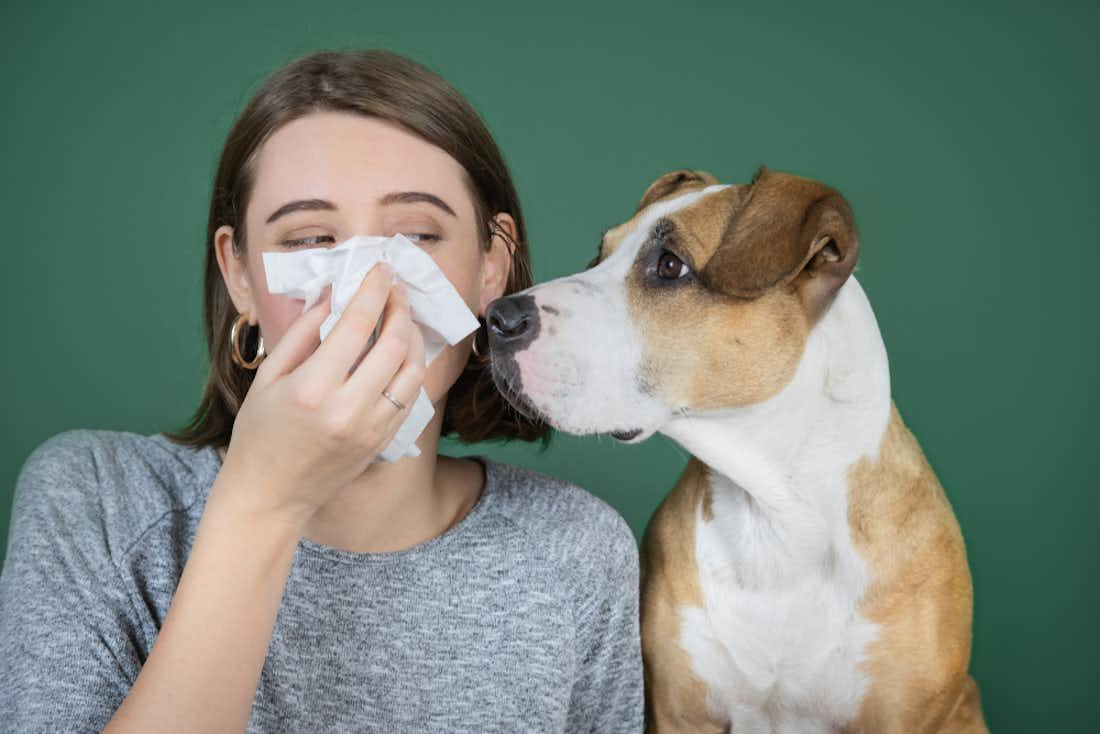Feb 15, 2022
The 5 Allergy-Induced Asthma Symptoms To Look Out For
5 minute read
Asthma is one of the most common respiratory illnesses in the United States, affecting nearly one in 13 Americans. If you have asthma, you’re already familiar with the shortness of breath and wheezing that all sorts of stimuli can trigger.
But if you’re noticing that your symptoms are worsening for one reason or another, did you know it might be due to hidden allergy triggers? Allergy-induced asthma is entirely common, and it can put a damper on your day.
Here are some of the common signs of allergy-induced asthma, as well as some simple ways to alleviate the discomfort.
What Is Allergic Asthma?
Asthma is a medical condition characterized by airways that narrow and swell, causing an excess of mucus. This makes it difficult to breathe, leading to shortness of breath or wheezing. Some people live comfortably with asthma, but it can be life-threatening for others.
Certain triggers can worsen the symptoms of asthma. Respiratory infections like the common cold, certain medications, stress, and acid reflux can restrict the airways and produce excess mucus. Additionally, physical activity can lead to exercise-induced bronchoconstriction, a narrowing of the airways caused by moderate to vigorous exercise.
However, allergens can also lead to worsening allergy symptoms. When an allergen enters your body, your immune system tries to fend off these foreign invaders by releasing IgE antibodies, or immunoglobulin E. When excess amounts of IgE are released, it can cause many allergy symptoms, including swelling of the airways.
When the airways become swollen because of allergies, this can cause anyone to experience symptoms similar to asthma. For those who have asthma that is triggered by their allergies, this is called allergic asthma.
Common allergic asthma triggers include outdoor menaces like pollen, cigarette smoke, or pollution. Indoor triggers usually include pet dander, dust mites, and mold spores.
Not sure if you’re experiencing asthma, allergies, or a combination of both? Here are some of the telltale signs of allergy-induced asthma.
(And don’t forget, you can always consult with one of Cleared’s US-licesned allergsists for more advice!)
1. Difficulty Breathing
Since asthma is caused by narrow airways with excess mucus production, it can make it difficult for air to pass through the airways and into the lungs. This leads to one of the most common asthma symptoms: shortness of breath or difficulty breathing.
Difficulty breathing can be frightening, as the sensation of not being able to fill the lungs with air is massively unnatural. If you’re feeling allergy-induced asthma, you may feel like you’re increasing the amount of effort in each breath, you’re feeling unsatisfied in each breath, and your breaths do not seem to fill the lungs to the point they usually would.
Some shortness of breath after physical activity or during periods of stress is normal, but it can become life-threatening if it worsens. Dyspnea is the medical term for shortness of breath, especially when accompanied by physical activity. The dyspnea scale can give you a good idea of whether or not to be concerned.
The dyspnea scale uses a range of zero to four, with zero being no breathlessness except during strenuous exercise and four being breathlessness when trying to perform simple activities, like getting dressed or cooking a meal.
If you feel unable to complete simple physical activities due to your allergic asthma, it’s time to schedule an appointment with an allergist.
2. Wheezing
Wheezing is a rattling or whistling sound that comes out of your airways when they are partially blocked. This strange sensation is caused by mucus within the respiratory passages for those with asthma, allergies, or allergy-induced asthma.
Typically, it’s caused by narrowing of the small bronchial tubes in the chest, which is where much of the built-up mucus from asthma resides. However, it can also occur due to obstruction of the vocal cords or larger airways.
Wheezing itself doesn’t necessarily pose any risks to your health, but the underlying cause might. If you’re wheezing, the chances are high that it’s also more difficult for you to breathe.
3. Tightness in the Chest
Sometimes, allergy-induced asthma can make it feel like there’s a tight band wrapped around your chest. This pressure is caused by swelling of the airways near or around the lungs, leading to tightness or tenderness.
While chest tightness is another symptom that does not always spell future health problems, this is a symptom that often precedes an oncoming asthma attack. Asthma attacks are potentially life-threatening asthmatic reactions, so it’s essential to monitor your other symptoms like heart rate and breathing ability if you feel some pressure in your chest.
4. Coughing
Your body is pretty good at recognizing when something is wrong. And when excess mucus in your airways impacts your ability to breathe easily, it does whatever it can to dispel the problem. Coughing is your body’s way of removing whatever irritates your lungs and airways.
While there is a form of asthma in which the only symptom is chronic coughing, allergy-induced asthmatic coughing typically coincides with chest tightness and wheezing. This is because the body is attempting to remove the extra mucus from your airways to make it easier to breathe.
While coughing is a necessary evil, it can still feel frustrating when your throat becomes raspy or dry when you cough too much.
5. Asthma Attack
While allergy-induced asthma is usually not enough to induce severe symptoms, asthma attacks are not out of the question. During an asthma attack, the airways become swollen and narrow, causing excess mucus production and leading to severe inability to breathe.
Symptoms of an asthma attack are essentially worsened symptoms of regular asthma.
Signs to look out for include:
- Severe shortness of breath
- Severe chest tightness
- Severe coughing and wheezing
- Low peak expiratory flow (PEF) readings
- Symptoms that fail to respond to an inhaler
- Inability to speak in more than short phrases
How To Treat Allergy-Induced Asthma
While there is no cure for asthma, there are plenty of ways to manage the symptoms and lead a happy, healthy life. However, you may be able to alleviate allergy-induced asthma by treating the underlying causes of allergies themselves.
Allergy Immunotherapy
Allergy immunotherapy is one of the only ways to treat the underlying causes of allergies, rather than just the symptoms. It works by gradually exposing your immune system to small amounts of an allergen over time. Then, by the end of treatment, pesky indoor and outdoor allergies will be no match for you.
How Does Allergy Immunotherapy Work?
There are two main types of allergy immunotherapy: sublingual and subcutaneous. Subcutaneous immunotherapy is often referred to simply as allergy shots. An allergist in-office administers these immunotherapy treatments. They function quite a bit like a vaccine, exposing your immune system to a small amount of an allergen to reduce your sensitivity and make you less susceptible to symptoms.
Sublingual immunotherapy, or SLIT, is a form of immunotherapy that requires nothing more than a tablet underneath your tongue. No needles, no discomfort, and no fuss – just a ton of relief.
And if allergies can’t bother you in the first place, you can worry less about allergy-induced asthma and other frustrating symptoms.
Who Are Allergy Shots For?
Subcutaneous immunotherapy is a great treatment option for anyone suffering from, seasonal allergy symptoms. If your symptoms come and go and are manageable with a prescription or over-the-counter antihistamines, you might not need to turn to immunotherapy at all. However, if allergies rule your life and make you miserable, it’s a great idea to talk to your allergist about shots.
Some factors to consider when looking into allergy shots are the cost of treatment, the duration of treatment, and your comfort level with needles. Here’s why it’s so important to give these potential concerns some thought before diving into immunotherapy.
Allergy Shots Can Be Expensive
Depending on the benefits you get from your job and where you live, allergy shots may or may not be covered by insurance. Even if your insurance does help you pay for the treatment, it can still be expensive, especially since it’s a recurring medical cost. Allergy shots are a long-term treatment, which means you’ll need frequent visits to the doctor’s office, potentially for several years.
If you’re suffering from uncomfortable, frustrating symptoms nearly year-round, the cost of subcutaneous immunotherapy could be worth it. It all comes down to how big your budget is for treatment, as well as how much your insurance can help you out.
Relief Medications
We love SLIT, but it’s not a quick process. In most cases, it can take up to three to five years of continuous dosage before you’re entirely allergy-free. However, if you need fast-acting relief, you’re still in luck.
Montelukast is an example of an anti-inflammatory that attacks different parts of the allergy pathway, making it easier for people with allergic asthma to take a breath of fresh air. This is best when used alongside other oral antihistamines and nasal sprays for holistic relief of every one of your symptoms.
(Our prescription power pack has everything you need to attack allergies from every angle!)
Inhalers
You have probably been prescribed an inhaler if you have asthma separately from allergic reactions. Also known as bronchodilators, these medications open the airways and help relieve acute asthma attacks. These are true lifesavers for people prone to asthma attacks, though they can also be used before, during, and after bouts of strenuous activity.
However, long-acting inhalers are also available by prescription. These help the airways relax, allowing more air to pass through. Unlike fast-acting bronchodilators, these work over time and are not intended for emergencies.
If you’re prone to allergy-induced asthma, having an inhaler is necessary and every asthmatic should have a rescue inhaler on hand at all times. These devices can make all the difference.
In Conclusion
Allergy-induced asthma is swelling or narrowing of the airways due to exposure to an allergen. Many different symptoms are important to know so you can have an idea of how to find relief.
The most common symptom is shortness of breath or the feeling that your lungs are not getting enough air. However, symptoms like chest tightness, wheezing, coughing, or even asthma attacks can be prevalent in allergic asthma patients.
Treating allergy-induced asthma usually focuses on diluting the allergy symptoms or asthmatic symptoms. To treat the underlying allergies, sublingual immunotherapy or antihistamines can bring relief. On the flip side, you can use inhalers to help open the airways and make it easier to breathe, especially during an asthmatic attack.
If you’re looking for relief from your allergy-induced asthma, your online allergist is here. Take your free allergy consultation today and see how easy allergy care can be with Cleared.
Sources:
Exercise-Induced Bronchoconstriction (EIB) | ACAAI Public Website
Shortness of breath | The Mayo Clinic
Measures of dyspnea in pulmonary rehabilitation | NCBI



